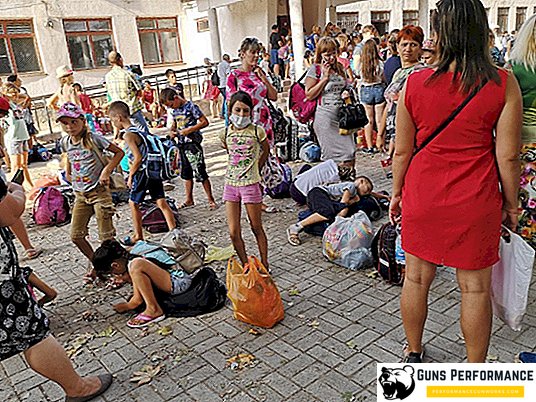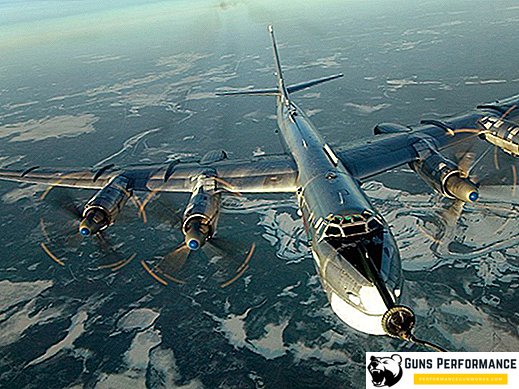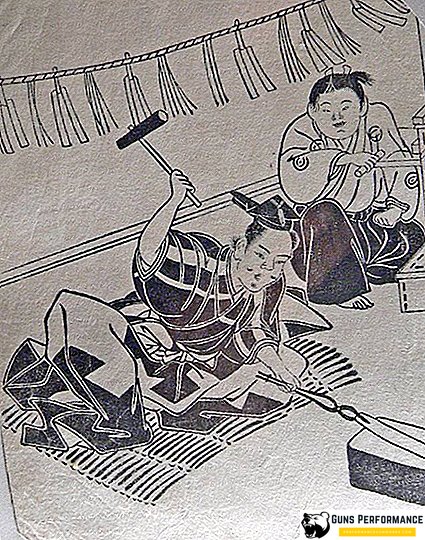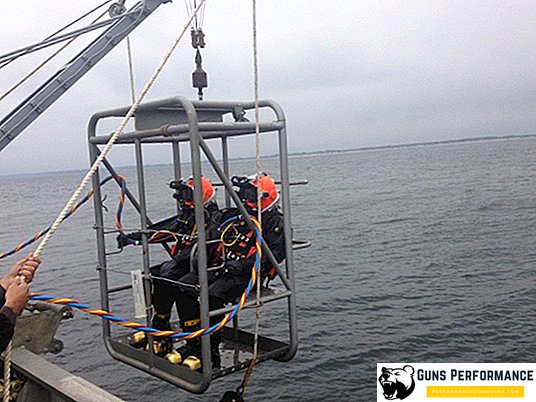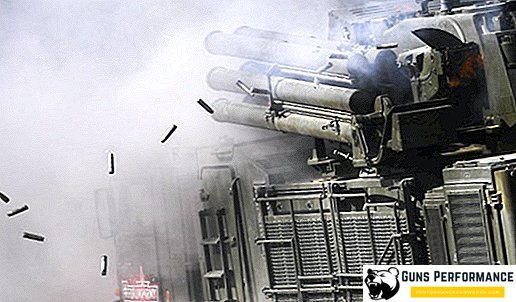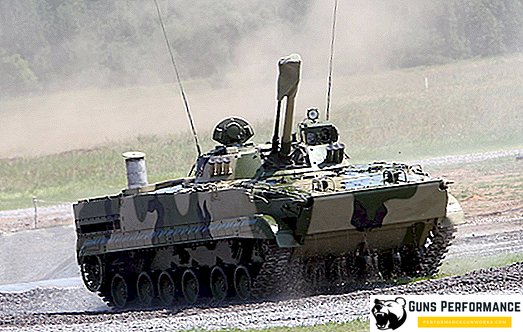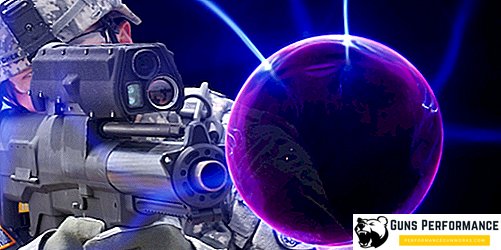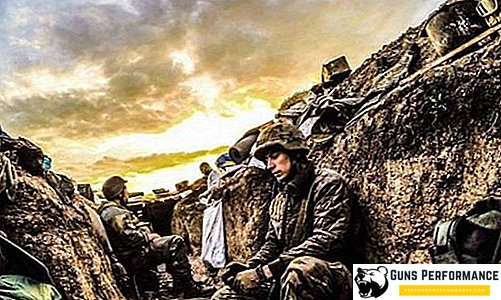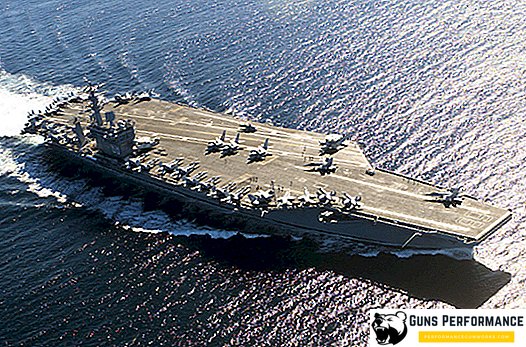The Russian Su-37 fighter is designed to achieve air superiority and pinpoint bombardment of ground targets. Su-37 "Terminator" was arranged in an aerodynamic configuration of "integral unstable triplane." The forward horizontal tail of the aircraft made it possible to increase its maneuverability at ultra-low speeds and supercritical angles of attack. Subsequently, the sketch drawings of the fifth-generation multipurpose experimental fighter of the fifth generation Su-47 “Berkut” were also created on it.

In the spring of 1996, the Su-37 fighter was first demonstrated to specialists and journalists at the aerodrome of the Flight Research Institute. Gromov in Zhukovsky. In September of the same year, at the air show in Farnborough, world specialists were able to observe an impressive aerobatics of the newest Russian fighter (piloted by Hero of Russia E. Frolov).

Engine design
The fighter is equipped with two powerful dual-circuit, turbojet engines AL-37FU (FP) with a vertical thrust vectoring, afterburner and rotating nozzle.

Engine drawings were developed at NPO Saturn. The design of the engine consists of:
- 4-stage low pressure compressor;
- 9-stage high pressure compressor;
- intermediate housing with a box of drives;
- outer contour;
- annular combustion chamber;
- low and high pressure single-stage cooling turbines;
- afterburner;
- supersonic, asymmetric jet nozzle.
The thrust vector control is directly controlled by the deflection (both differential and synchronous) of the engine nozzles in the range of +/- 5 degrees.

Features of weapons
The fighter’s full armament consists of:
- air-to-air and air-to-surface missile classes;
- unguided rocket and bomber;
- gun-rifle.
Bomber and rocket armament is installed on 12 suspension points with the help of airborne ejection devices, girder holders, air launch devices. It is possible to install X-29/31, R-27/60/73/77 missiles, cassettes and bombs weighing not> 500 kg.

The air-to-air guided weapons include:
- 8 medium-range semi-active radar missiles of the type R-27 or with thermal homing heads of the type R-27T;
- 10 missiles with radar homing RVV-AE medium range;
- 6 short-range missiles with thermal homing head R-73.
The set of controlled air-to-surface weapons includes:
- 6 S-25LD or X-29L missiles (with laser semi-active homing heads) and X-29T missiles (with television homing heads);
- 6 Kh-31A missiles (anti-ship with radar active homing heads);
- 6 Kh-31P missiles (anti-radar with passive homing heads);
- 2 Kh-59M missiles (medium range with a command-television guidance system);
- 6 bombs KAB-500KR (adjustable with homing correlation-television heads).
The composition of the unguided rocket-bomb armament includes:
- bombs FAB-500M62 / 14 pcs. or bombs of type FAB-500m64 / 16 pcs. or incendiary tanks ZB-500/14 pcs. or bombs of type FAB-250M54 / 34 pcs. with mounting on girder holders;
- bombs like OFAB-100-120 / 48;
- C-8/120 missiles;
- S-13/30 missiles;
- missiles C-25/6 pieces.
Perhaps 70 different variations of the placement of weapons on external hangers.
Gun and rifle weapons are represented by single-barreled, rapid-fire gun type GSH-301. Its caliber - 30 mm, and ammunition - 150 rounds.

Complex of onboard electronic equipment
The Su-37 aircraft (as well as the newest Su-47 Berkut) is equipped with integrated on-board electronic equipment with an electric remote digital control system (EDS) for flight. It is made according to the triple redundancy scheme in the lateral control channels and fourfold redundancy in the longitudinal channel.
Located on board the new defensive complex significantly expanded its capabilities through the use of a new generation of infrared and radio intelligence stations. Special means of setting infrared and radar interference, warning systems and suppressing the radar exposure of the enemy (IR traps, automatic dipole reflector) work in the radar and optical ranges.
Communication equipment includes a satellite communications system, as well as radio stations of the HF and VHF bands, equipped with special telecode protection equipment.

The cockpit of the Su-37, after appropriate revision, received a rationally designed information and control field. It has four large-format indicators on color LCD matrices with enhanced protection against illumination, and a wide-angle collimator indicator against the background of the windshield.
For higher accuracy of piloting and exclusion of the possibility of involuntary shifting of the control knobs, at the moment when the speed is high, in the cockpit of the aircraft, instead of the central control knob, a side low-stroke was installed. The same type of control knob is also used on the fifth generation fighter - the Su-47 Berkut. The usual installed thrusters (engine control levers) have been replaced with tensorol, which allow changing the thrust with the help of joysticks.

The aiming system includes a laser range finder-target designator combined with a thermal imager and provides recognition and automatic tracking of several air targets. The radar and optical-location system are combined, and together with the installed protection equipment of the data exchange system, allow coordinating the actions of several aircraft in the conduct of group combat.
New maneuverable capabilities of the Su-37
The twin-turbojet engines installed on the Su-37 Terminator aircraft with a vector thrust controlled and variable in-flight system make it possible to develop a speed of up to 2500 km / h with a maximum afterburner load of 14,500 kgf. Such technical capabilities of the engines give a serious increase in the lift force, as well as the ability to quickly change the orientation of the fighter body at angles of up to 180 ° and hold it in such a position sufficient for the launch of the rocket. It is the stability of movement (constant speed, no altitude loss) at high angles of attack, the ability to control the pitch in flight dynamics, allowed to perform new, unique aerobatics.
- Coup on the bell. Used to "trick" tracking radar, followed by a 180 ° reversal.
- Cobra Pugacheva with an angle of attack from 150 ° to 180 °. Used in combat to maneuver aerodynamic braking.
- Chakra "Frolova". Allows during the battle to skip the enemy ahead, thereby taking him into the sight of the guns.

The Su-37 belongs to the few fighters on which it is possible to execute an exciting maneuver - “Pugachev's cobra”. The angle of attack (the angle between the velocity vector of the aircraft and its longitudinal axis) at maneuver can reach values equal to 180 °, while usually pilotage comes with angles of attack of 10-15 °. In carrying it out, the plane sharply raises its nose perpendicular to the ground and throws itself back for 3-4 seconds, as it were, “stands on its tail” (observers have the impression that it is moving “tail forward”). The speed when performing such a complicated piloting technique is constant and passes almost without loss of height, which allows the aircraft to occupy the most advantageous position in the melee, ensuring its superiority over the enemy.
Video about SU-37
Compared with its predecessors, the Su-37 demonstrates the best tactical performance, which makes it possible to:
- not entering the enemy air defense zone, carry out an attack of ground targets;
- automation of all flight modes and stages of combat use;
- synchronization and automation of group actions and attacks on air and ground targets;
- countering optical-electronic and electronic means of the enemy;
- launching a warning strike at the enemy, including those equipped with latent movement systems;
- multi-channel protection of all sighting and information systems.


